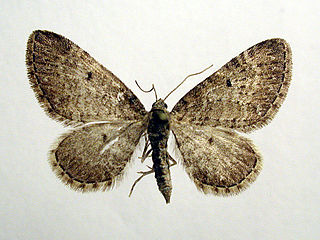
Eupithecia satyrata, the satyr pug, is a species of moth of the family Geometridae. It was described by Jacob Hübner in 1813. It is found from Ireland, through northern and central Europe east to all of Russia and central Asia and western Siberia to Tibet. It is also present in North Africa and North America.
Eupithecia insolabilis is a moth in the family Geometridae first described by George Duryea Hulst in 1900. It is found in the southern United States, including Utah, Arizona and New Mexico.
Eupithecia catalinata is a moth in the family Geometridae first described by James Halliday McDunnough in 1944. It is found in the southern United States, including Utah, Arizona and New Mexico.

Eupithecia bryanti is a moth in the family Geometridae first described by Taylor in 1906. It is found from Alaska, the Yukon Territory, Alberta and British Columbia, through Washington, Oregon, Montana, Idaho, Wyoming and Utah to California.

Eupithecia borealis is a moth in the family Geometridae first described by George Duryea Hulst in 1898. It is found in North America, including Alberta, Arizona, British Columbia, California, Colorado, Manitoba, Michigan, Montana, New Brunswick, New Mexico, New York, Newfoundland and Labrador, Nova Scotia, Ontario, Quebec, Utah and Wyoming.
Eupithecia casloata is a moth in the family Geometridae first described by Harrison Gray Dyar Jr. in 1904. It is found in North America, including Yukon, British Columbia, Alberta, Saskatchewan, New Brunswick, Newfoundland and Labrador, Quebec, Washington, Montana, Oregon, Wyoming, Colorado, Utah, California, Maine and New Hampshire.
Eupithecia nabokovi is a moth in the family Geometridae first described by James Halliday McDunnough in 1946. It is found in the US states of California, Arizona, New Mexico, Utah, Colorado and Wyoming.

Eupithecia nimbicolor is a moth in the family Geometridae first described by George Duryea Hulst in 1896. It is found in North America from eastern Newfoundland and Labrador to western British Columbia and from Alaska to Arizona.

Eupithecia cimicifugata is a moth in the family Geometridae first described by Pearsall in 1908. It is found in North America, including Alberta, Ontario, Saskatchewan, Kentucky, Maryland and South Dakota.
Eupithecia nimbosa is a moth in the family Geometridae first described by George Duryea Hulst in 1896. It is widespread in the Rocky Mountains, from Arizona to the Canada–US border.
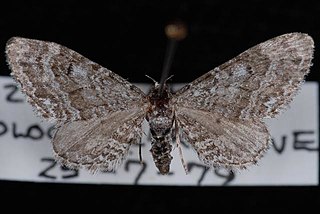
Eupithecia perfusca is a moth in the family Geometridae first described by George Duryea Hulst in 1898. It is found in western North America.
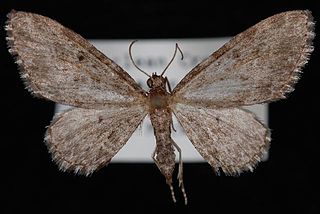
Eupithecia lachrymosa is a moth in the family Geometridae first described by George Duryea Hulst in 1900. It is found in North America from central Saskatchewan west to southern Vancouver Island, north to British Columbia and Alberta and south to California.
Eupithecia subcolorata is a moth in the family Geometridae first described by George Duryea Hulst in 1898. It is found in western North America, from British Columbia south to Arizona and New Mexico.

Eupithecia stellata is a moth in the family Geometridae first described by George Duryea Hulst in 1896. It is found in North America from central Manitoba to northern Alberta and south to California and Mexico.

Eupithecia niveifascia is a moth in the family Geometridae first described by George Duryea Hulst in 1898. It is found in North America from south-western Alberta west to Vancouver Island, north to northern coastal British Columbia and south to New Mexico.
Eupithecia flavigutta is a moth in the family Geometridae first described by George Duryea Hulst in 1896. It is found in the United States in Colorado and montane forest areas in eastern Arizona and south-western New Mexico.
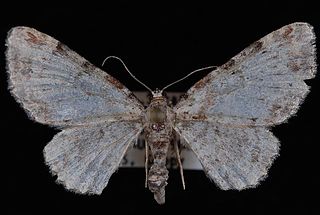
Eupithecia mutata, the spruce cone looper or cloaked pug, is a moth in the family Geometridae. The species was first described by Pearsall in 1908. It is found in the northern Atlantic and New England states in North America. In Canada, the range extends from Nova Scotia to northern Ontario.
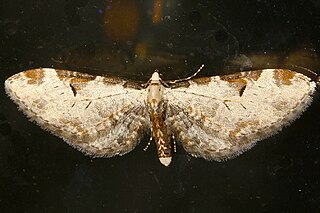
Eupithecia nevadata is a moth in the family Geometridae first described by Alpheus Spring Packard in 1871. It is found in western North America.
Eupithecia slossonata is a moth in the family Geometridae first described by James Halliday McDunnough in 1949. It is found in the US states of Florida, Georgia, Kentucky and Maryland.

Eupithecia placidata is a moth in the family Geometridae first described by Taylor in 1908. It is found in western North America from British Columbia south to California.












